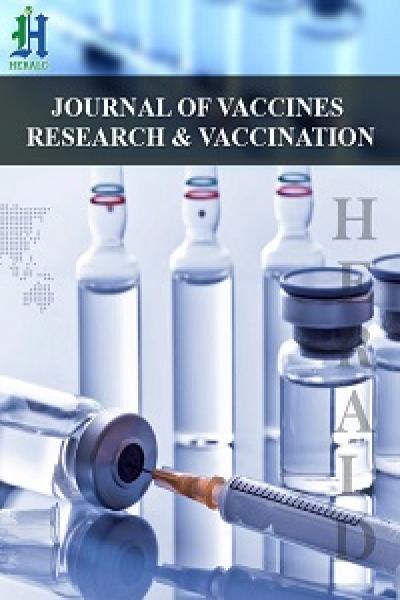
Pneumococcal Conjugate Vaccines (Pcvs) Introduction in the Immunization Program and its Impact on Mortality Under 5 Years in Guyana, South America
*Corresponding Author(s):
Anthonisamy VRDepartment Of Statistics, University Of Guyana, Guyana
Tel:+592 6238325,
Email:vincent.anthonisamy@uog.edu.gy
Keywords
Correlation; Linear regression; Pneumococcal Conjugate Vaccines.
Introduction
Pneumococcal infections are one of the most important causes of diseases in children under 5 years of age in countries throughout the world. Streptococcus pneumoniae (S.pneumoniae or pneumococcus) causes a variety of clinical syndromes, including pneumonia, meningitis, and bacteremia, as well as milder but more common illnesses such as otitis media and sinusitis [1].The World Health Organization (WHO) in 2012 recommended the introduction of pneumococcal conjugate vaccines (PCVs) in childhood immunization programs with high priority to countries with mortality rate >50 deaths/1000 births in children under 5 years of age [2]. Guyana has registered 517 deaths over the period 2000 to 2013 under the age of 5 years with the median age at death of 6 months due to respiratory system related illness, therefore in the light of the high number of respiratory illnesses and deaths the PCV vaccines were introduced.
Pneumococcal conjugate vaccines (PCVs) were first licensed in 2000. There are currently two commercially available vaccines. The first PCV to be developed, PCV7 Prevnar (7- valent, PCVs7), was licensed in 2000 in 2010, Synflorix (10-valent, PCV10) and Prevnar (13-valent, PCV13) were introduced to the market and replaced PCV7. PCV10 includes antigens for the seven S. pneumoniae serotypes in PCV7 and serotypes 1, 5,7F, while PCV13 includes antigens for the aforementioned 10 serotypes as well as 3, 6A, and 19A. All three vaccines have demonstrated excellent safety and efficacy profiles in clinical trials [2]. Guyana initiated the PCV 7 vaccines for children who were immunized suppressed and later in 2011-2012, did the nationwide introduction of PCV 13 to the under 1 years old. Three doses of these vaccines were given at 2 months, 4 months and 6 months. These vaccines were given from Regions 1-10 years throughout Guyana. Pneumococcal infections are one of the most important causes of diseases in children under 5 years of age in countries throughout the world. Streptococcus pneumoniae (S. pneumoniae or pneumococcus) causes a variety of clinical syndromes, including pneumonia, meningitis, and bacteremia, as well as milder but more common illnesses such as otitis media and sinusitis [1].
Several studies have reported on the effectiveness and impact of both PCV10 and PCV13 on the reduction of meningitis and pneumonia hospitalizations. However, there is scarce evidence on the impact of PCVs on mortality in children under 5 years of age. This is mainly due to challenges in accessing and analyzing nationwide mortality data. In Latin America countries, and Caribbean including Guyana data is routinely collected on morbidity and mortality data but no analysis has been done on the available data or the disease burden. There is a need to review the impact of this disease in view of the introduction of Pneumococcal Conjugate Vaccines (PCVs) in countries and Guyana [3].
Objective
Assess the impact of routine childhood PCV vaccination on the mortality of children under 5 years of age due to all-causes, and also due to pneumonia infections as being the underlying cause of death.
Materials and Methods
This study used an ecologic study design by the reviewing of available secondary mortality data 2000 to 2013 from the Ministry of Public Health, Statistical Department. This included the period when no PCVs vaccination occurred prior to 2010, transition period, when vaccine was introduced in the country and coverages were still low 1 year after (in this case this was 50%) introduction and post-vaccine introduction period, when PCVs was routinely offered to all infants in all states in the country. Data was extracted without personal identifiers by the use of Excel software for the age at death below 5 years. The total sample size was 4931. As a specific cause of death that the authors interested in were deaths due to respiratory system. There were 517 cases registered under this category. Crude Mortality rates and cause specific mortality rates were calculated and compared. Frequency distributions with percentages, descriptive statistics such as mean, median and standard deviation, correlation and linear regression models were calculated for interpretation and prediction purposes.
Data analysis was done using SPSS 20.0 for the deaths due to pneumonia, as coded in the International Classification of Diseases 10th edition (ICD10) as J12-J18, and sub codes, deaths due to all-cases, including any cause as coded in the ICD10 under 5 years and deaths due to all respiratory causes, including all J00-J99 codes in the ICD10. G00-G99 In addition, diseases of the nervous system was also added to the group of RTIs due to the complications such as bacterial meningitis. Trends of observed monthly mortality rates during the post PCVs introduction period was compared with rates in the pre-vaccine period. The mortality rate for below the age of 5 was calculated as Mortality Rate= (Total Number of Deaths in the particular year) / (Total Number of live births in the same year)*100,000.
Results
|
Year |
Total population |
Population In children under-5 |
Infant Mortality*1000 |
PCV Vaccination Coverage (%) |
|
2010 |
746,955 |
74,256 |
14.7 |
- |
|
2011 |
746,955 |
72,326 |
14.8 |
50 |
|
2012 |
746,955 |
70,440 |
13.8 |
90 |
|
2013 |
746,955 |
68,510 |
13.6 |
96 |
Table1: Guyana Bureau of Statistics Population and housing Census 2012, IMR and PCV coverage -Ministry of Public Health Data. Total population, under-5 population, infant mortality, PCV vaccination coverage for 3 doses, Guyana, 2010-2016 [4].
(Table 1) shows demographic information including total population, under-5 population, from 2010 to 2016; the infant mortality rate from 3.6 to 4.1 for 1000 births and the PCV vaccination rate was 50% in 2011 and increased to 95 % at the end of 2016 [5] .
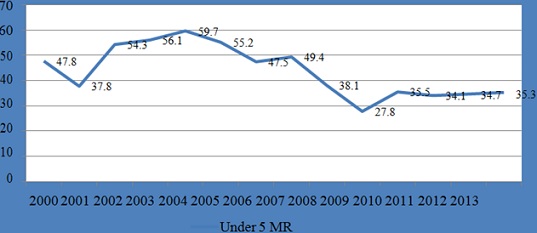 Figure 1: Ministry of Public Health, Statistical Department 2017 Guyana under 5 mortality rate per 1,000 from 2000-2013, the study reviewed 4,931 mortality cases from 2000-2013 (refer Table 2) from the Ministry of Public Health data base.
Figure 1: Ministry of Public Health, Statistical Department 2017 Guyana under 5 mortality rate per 1,000 from 2000-2013, the study reviewed 4,931 mortality cases from 2000-2013 (refer Table 2) from the Ministry of Public Health data base.
In [Figure 1] it was observed that the year 2004 has the highest mortality rate of 59.8 deaths in 1,000 births; this was due an outbreak of neonatal infections in the main referral hospital. Quality standards measures were put in place and this infection subsided. As the years progressed, there was a steady decline in the mortality rate to 35.3 per 1, 000 births at the end 2013. This trend line illustrates the downtrend in the mortality rate under 5 years in Guyana [6].
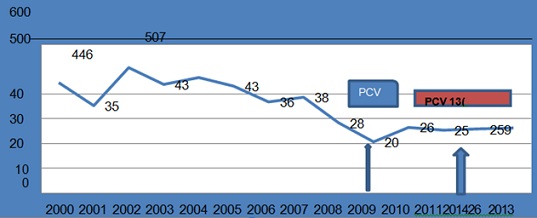 Figure 2: Mortality cases under 5 years prior to PCV vaccine Introduction and after in Guyana.
Figure 2: Mortality cases under 5 years prior to PCV vaccine Introduction and after in Guyana.
In [Figure 3 and Table 3] below, the mortality was highest in the under 1 age group; this is because that most causes of deaths under 5 years occurred in the perinatal period.
When this was compared with the introduction of the PCV vaccines, it was shown that the mortality rate was highest in the period prior to vaccination in 2011 and decreased to 263-254 cases (refer Figure 2).
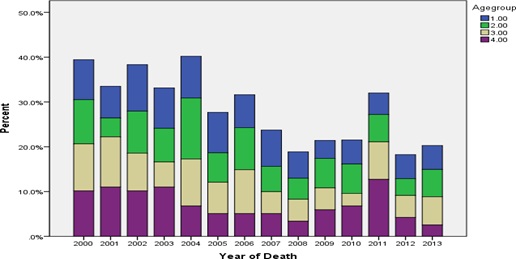 Figure 3: Mortality in children under the age specified groups from 2000-2013.
Figure 3: Mortality in children under the age specified groups from 2000-2013.
With reference to [Table 2], P00-P96- certain conditions originating in the perinatal period had 2052, with a mortality rate of 41.6 per 1000. Respiratory tract infections accounted for ICD G00-G99 and J00-J99 with a total of 517 cases (refer Table 2).
|
Causes of Death |
# U5 yrs deaths |
Percent |
|
A00-B99 Intestinal infectious diseases, tuberculosis, Certain Zoonotic bacterial diseases, Other bacterial diseases etc… |
801 |
16.24 |
|
C00-D49- Malignant neoplasm |
95 |
1.92 |
|
D50-D89- diseases of the blood and blood-forming organs and certain disorders involving the immune mechanism |
70 |
1.41 |
|
E00-E89- Endocrine, nutritional and metabolic diseases including malnutrition, metabolic disorders |
230 |
4.66 |
|
G00-G99- Diseases of the nervous system- including bacterial meningitis |
118 |
2.39 |
|
H60-H95- Diseases of the ear and mastoid process |
1 |
0.02 |
|
I00-I99- Diseases of the circulatory system |
177 |
3.58 |
|
J00-J99- Respiratory tract infections |
399 |
8.09 |
|
K00-K95- diseases of the digestive system |
75 |
1.52 |
|
L00-L99- Diseases of the skin and subcutaneous tissue |
4 |
0.08 |
|
M00-M99- Diseases of the musculoskeletal system and connective tissue |
3 |
0.060 |
|
N00-N99- Diseases of the genitourinary system |
27 |
0.547 |
|
O00-099-diseases of the maxilla facial etc |
1 |
0.020 |
|
P00-P96- certain conditions originating in the perinatal period |
2054 |
41.65 |
|
Q00-Q99- Congenital malformations, deformations and chromosomal abnormalities |
466 |
9.45 |
|
R00-R99- symptoms, signs and abnormal clinical and laboratory findings, not elsewhere classified |
56 |
1.13 |
|
V00-Y99- External causes of morbidity |
355 |
7.199 |
|
Total |
4931 |
100 |
Table 2: ICD Classification of diseases under 5 years.
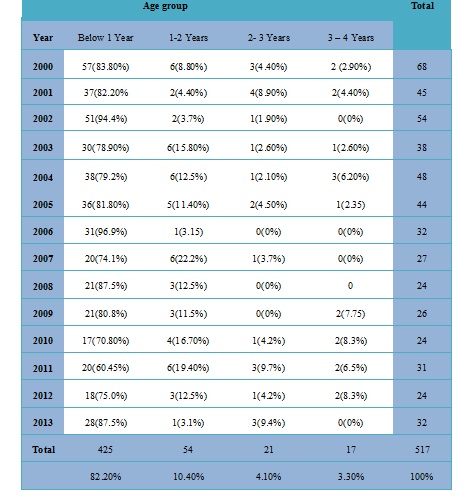 Table 3: Age specific deaths for children below 5 years from 2000 to 2013 due to respiratory related illnesses and complications.
Table 3: Age specific deaths for children below 5 years from 2000 to 2013 due to respiratory related illnesses and complications.
In [Table 3], it is observed that 82% (425 cases) of the deaths due to respiratory related illness occurred below 1 year for the period 2000 to 2013. In [Figure 2], it is shown that the UM5R due to respiratory tract infections and complications decreased from 2000-2013 therefore, it is vital to continue to implement PCV vaccines into the national immunization programme. 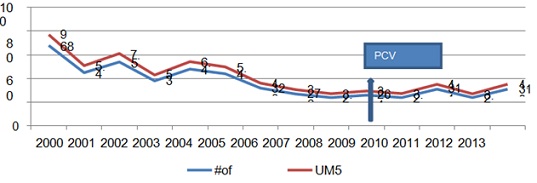
Figure 4: Under 5 mortality due to respiratory tract infections and complications.
|
|
Correlations |
||
|
|
|
Year |
Number of deaths
|
|
Year
|
Pearson Correlation Sig. (2-tailed) N |
1
17 |
-.882** .000 17
|
|
Number of deaths
|
Pearson Correlation Sig. (2-tailed) N |
-.882** .000 17 |
1
17 |
Table 4: Pearson correlations according to the number of deaths Correlation is significant at the 0.01 level (2-tailed).
There is a high negative correlation (-0.882) between Year and the number of deaths due to respiratory related illness for the children below 5 years of age and the correlation is highly significant since the p-value=0.000
|
Coefficientsa
|
|||||
|
Model |
Unstandardized Coefficients |
Standardized coefficients |
t |
Sign. |
|
|
B |
Std.Error |
Beta |
7.279 |
.000 |
|
|
1 (Constant) |
5190.922 |
713.106 |
-7.233 |
.000 |
|
|
Year |
-2.569 |
0.355 |
-0.882 |
||
Table 5: A simple linear regression models to predict the number of deaths is shown in the above.
Linear regression model to predict the number of deaths.
a. Dependent variable: Number of deaths
As the year progresses, the number of deaths reduced by 2.569 times. The linear regression model is significant since the p-value = 0.000 < 0.05 and the coefficient of determination (R-square) is 77.7%. This shows that the implementation of PCV Vaccination contributes almost 78% in reduction of number of deaths due to respiratory related illness for children under 5 years of age.
Discussion
In the research, we can conclude that after the introduction of PCV vaccines the under 5 mortality rate has been decreased over the years including the respiratory tract infections. This is aligned to studies conducted to evaluate the impact of PCVs. According to South Africa following PCV introduction and the improvement in HIV interventions, 41,800 (95% CI 28,000-50,000) severe pneumococcal disease cases were estimated in 2012-2013 with a rate reduction of 1,277 cases per 100,000 child-years.
In addition Scotland revealed similar result. There was an 11 % reduction in deaths due to all-cause pneumonia, and 30 % reduction in pneumococcal hospitalizations across all age groups in the post-PCV13 period compared with pre-PCV period [4].
From this study, it was noted that the group most affected was under 1 year. The main cause of death was certain conditions originating in the perinatal period, 2052, with 41.65 %, followed by intestinal infectious diseases 801 with 16.24% and respiratory tract infections and complication 517 with 10.48%.
The linear regression model was significant with the p-value =0.000<0.05 and the coefficient of determination (R-square) is 77.7%. This shows that the implementation of PCV Vaccination contributes almost 78% in reduction of number of deaths due to respiratory related illness for children under 5 years of age.
Conclusion
This clearly shows that the national authorities should continue to invest in PCV vaccination to implement this vaccination and also look into other major causes of death and prepare a disease control chart for the administration to take necessary actions.
References
- O'Brien KL, Wolfson LJ, Watt JP, Henkle E, Deloria-Knoll M, et al. (2009) Burden of disease caused by Streptococcus pneumonia in children younger than 5 years: Global estimates. Lancet 374: 893-902.
- Valenzuela MT, O'Loughlin R, De La Hoz F, Gomez E, Constenla D, et al. (2009) The burden of pneumococcal disease among latin american and caribbean children: Review of the evidence. Rev Panam Salud Publica 25: 270-279.
- WHO (2012) Pneumococcal vaccines WHO position paper-2012. Wkly Epidemiol Rec 87: 129-144.
- De Oliveira LH, Trumbo SP, Matus CR, Sanwogou JN, Toscano CM (2016) Pneumococcal conjugate vaccine introduction in Latin America and the Caribbean: Progress and lessons. Expert Rev Vaccines 15: 1295-1304.
- Samuel BG, Neil JS (2008) using SPSS for windows and Macintosh analyzing and understanding data, 5th edn. Pearson/Prentice Hall International, UK.
- Dataspace (2012) Guyana 2012 Population & Housing Census Questionnaires. Bureau of Statistics, Georgetown, Guyana.
Citation: Anthonisamy VR (2022) Pneumococcal Conjugate Vaccines (PCVs) introduction in the Immunization Program and its Impact on Mortality under 5 years in Guyana, South America. J Vaccines Res Vaccin 8: 019.
Copyright: © 2022 Anthonisamy VR, et al. This is an open-access article distributed under the terms of the Creative Commons Attribution License, which permits unrestricted use, distribution, and reproduction in any medium, provided the original author and source are credited.
